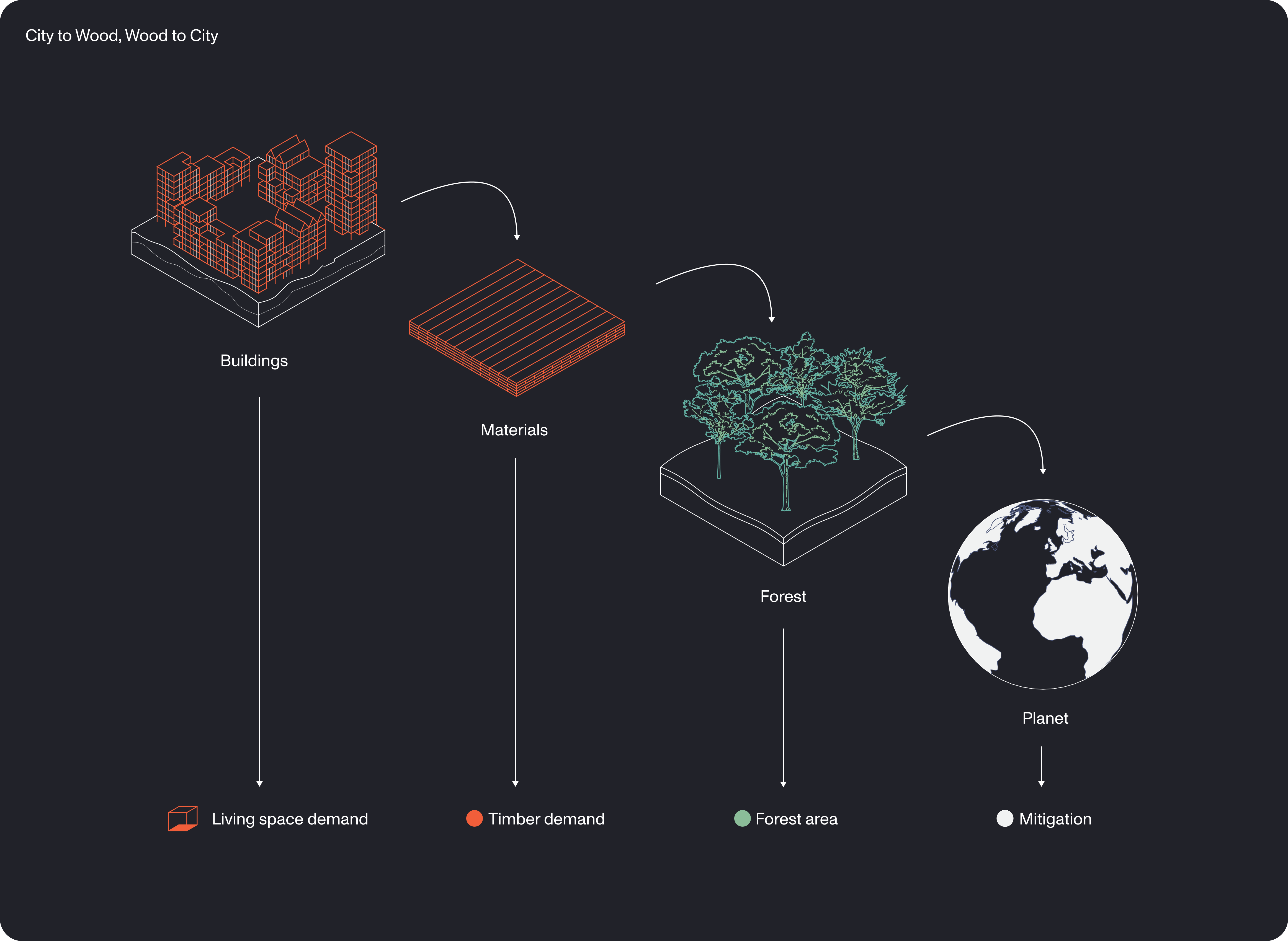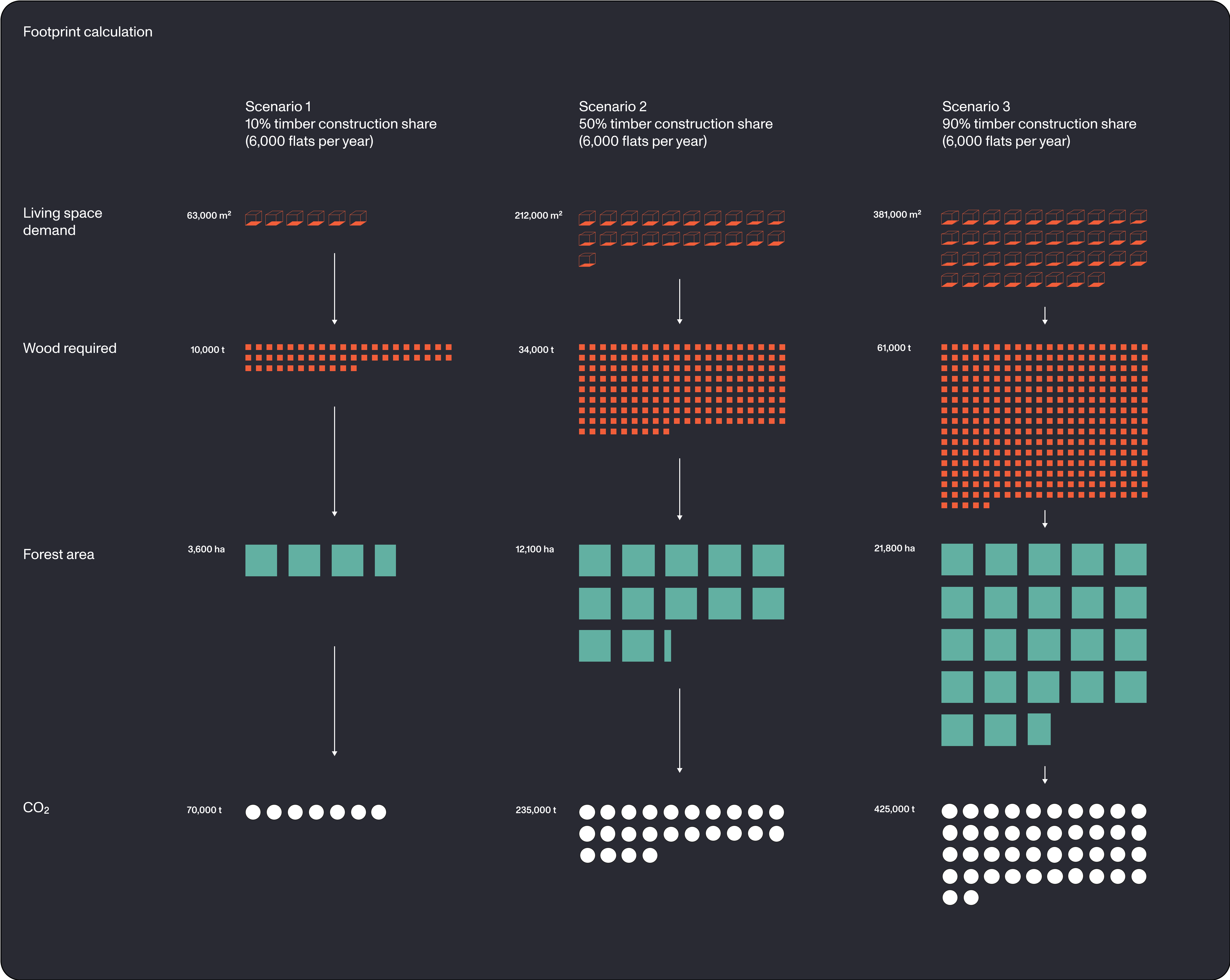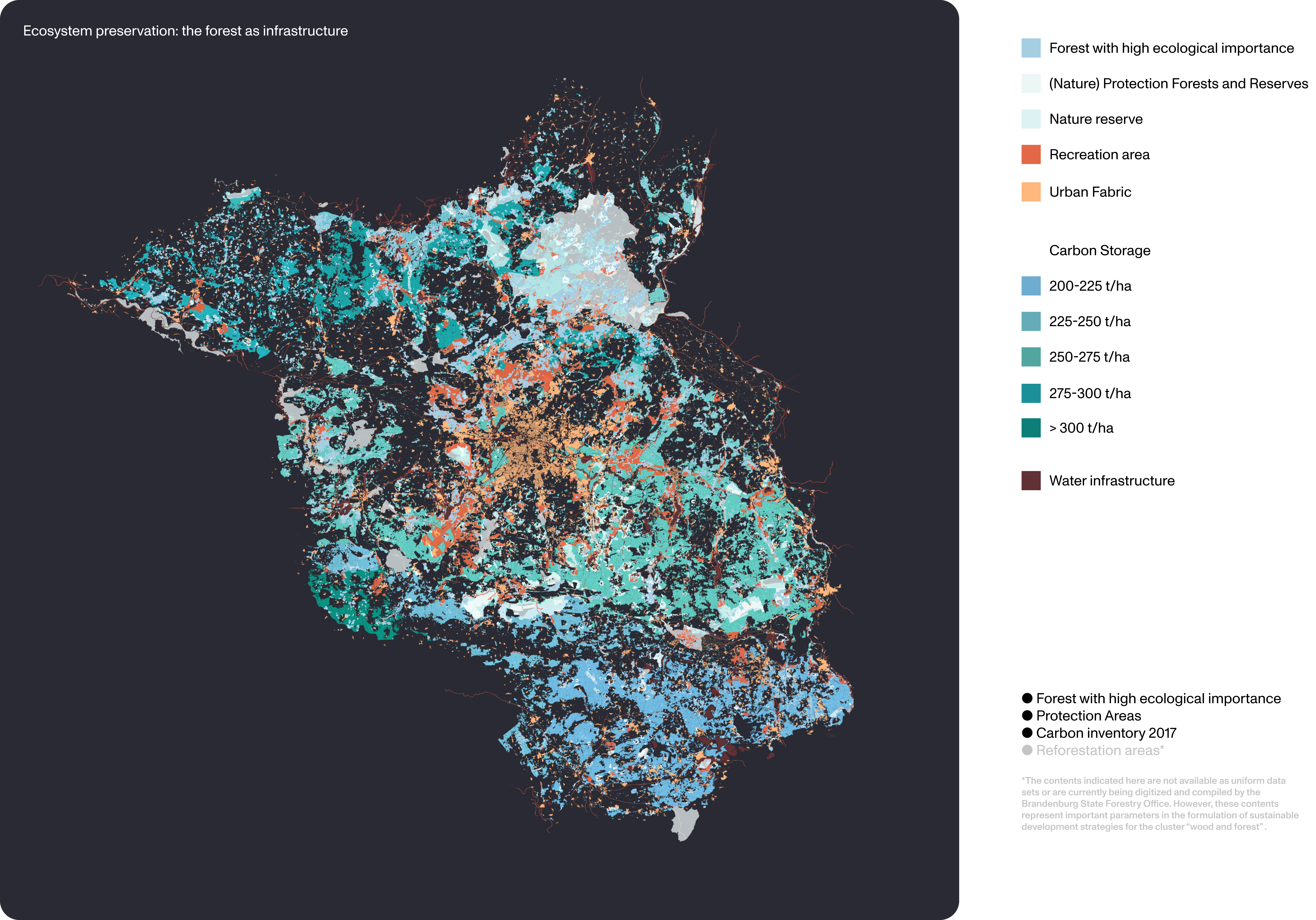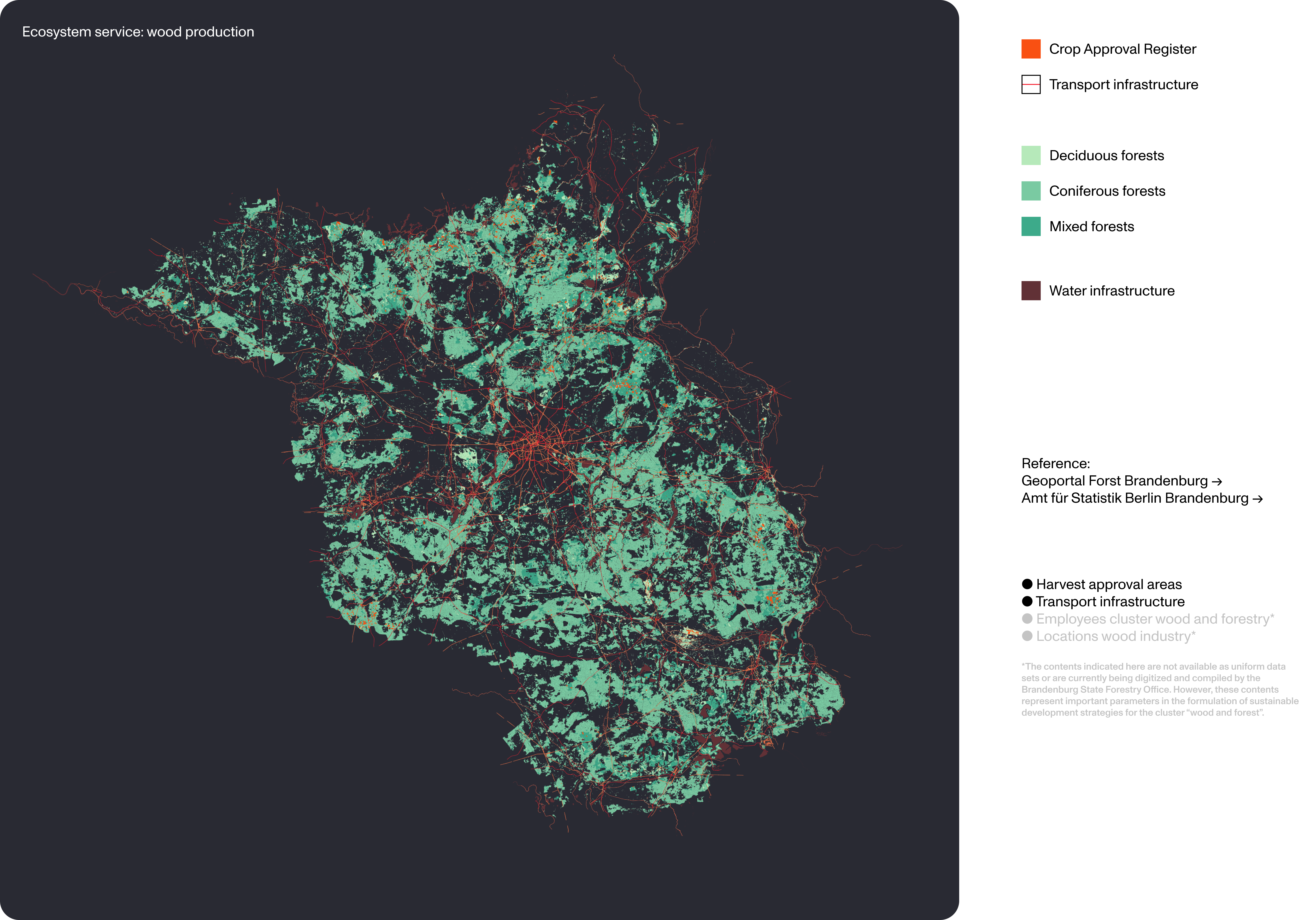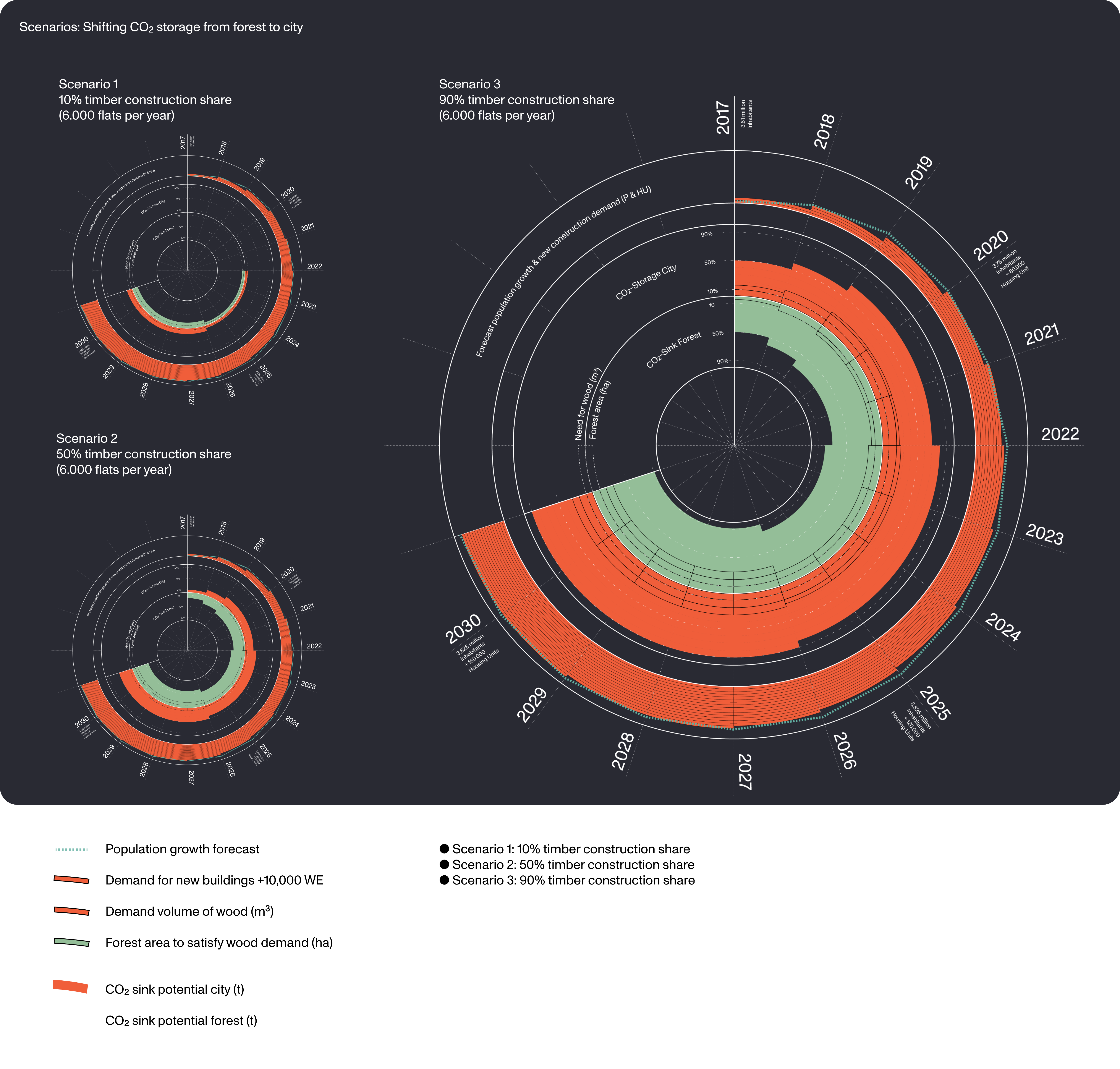INVESTIGATIONS! Article
Coupling Ecosystems: Carbon Sinks in Forests and City in Berlin-Brandenburg (I)
By: LIVING SYSTEMS
Leonard Schrage, Partner
Martin Bittmann, Partner
Julia Dorn, Researcher
CONTRIBUTING EXPERT:
Daniel Dieren, Researcher
FOR MORE INFORMATION:
www.complex.institute
research@complex.institute
www.living.systems
whole.crew@living.systems
Published on April 22, 2021

In the forests of Brandenburg and Berlin, one cubic metre of wood grows every three seconds. This means that enough wood grows within 1.5 minutes to build a single family house – in theory.
Forests as infrastructure. How much can – and should – they afford us in the future?
Today we know that timber not only scores as one of the best building materials in terms of life-cycle assessments and environmental cost indicators, but that its storage capacity for CO₂ will also be a decisive factor in bringing about sustainable building and climate neutrality in our cities. Pilot projects such as the Schumacher Quartier rely almost entirely on renewable raw materials and, above all, on local production and manufacturing methods.
However, in order to anchor urban timber construction sustainably in the city and its (re)development, it is necessary to pursue a systemic approach and to focus on our forests and natural ecosystems. In addition to linking urban and rural ecosystems, forest conversion will play an important role in meeting the increasing demand. Only closer networking and balance between demand, capacity of the ecosystems and production can pave the way.
While the first part (Diagnosis) of Living Systems’s series Coupling Ecosystems explores the status quo of linkages between the forest and urban timber, the second part (Transformation) investigates various sensing technologies and their evolving potential in quantifying important aspects in the effort towards Coupling Ecosystems.
This article was originally developed for, and published in full-length, on Complex, Living Systems’ research journal on the Digital City and Planetary Architecture. It features contributors from various academic and applied disciplines, such as data scientists, robotic engineers, forestry experts, sociologists and behavioural psychologists.
Click on the hyperlinks on the right or read the full feature here and discover interactively how actors, (eco-)systems and infrastructures are intertwined.
PART 2//
See Part II Transformation (coming soon)
STORYLINE//
See how actors and factors along the supply chain from Wood to City are connected in Complex´ digital storytelling of “Urban Scale Timber”
1 Stakeholders & Impact
It’s vital that we achieve a broader understanding of systemic interrelationships between building with wood, urban CO₂ storage, natural ecosystems and digitalisation. The goal is to highlight the potentials for the environment and the city which lie in urban timber construction and the infrastructures of sustainable forestry. Because transformation towards urban timber, and climate-friendly, construction also means a transformation of natural forest systems and all systemic elements that connect city and forest.
DIAGRAM//
See SDGs, fields of action and stakeholders come together
2 Demand
Once established, urban timber construction would place entirely different demands on the forest compared to the status quo. Brandenburg’s forests, however, have the potential to keep pace with such a transformation. The decisive parameters are the construction industry and the demand for the raw material wood, which are mainly influenced by the regulatory framework created by the federal, state, and local governments.
With his university research project Wood to City, City to Wood, Daniel Dieren developed various planning scenarios that consider the entanglement between the construction industry, architecture, and CO₂ cycles. In addition to global cycles, the examples presented in the publication also deal with potentials for urban CO₂ storage and timber construction applications for the Berlin housing market.
PAPER//
Wood to City, City to Wood
The renewable building material wood is a carbon sink. Sustainable, bio-based materials need carbon for their growth, which is taken from the atmosphere in the form of carbon dioxide (CO2) – a process which actively binds carbon and releases oxygen. Provided our forests bind more carbon than is released by the timber harvest, the forestry and wood products sector will serve as a global carbon sink.
Wood and wood-based materials are substitute materials. By using more wood, we also avoid carbon dioxide emissions caused by using mineral-based building materials. The sustainable use of wood as a mitigation and substitute building material thus becomes part of a global climate strategy. The effect of timber products as a CO₂ sink is shown here at four levels of observation – building, material, forest, and planet.
CONTRIBUTING EXPERT//
Daniel Dieren
DIAGRAM//
On each level there is great detail to discover regarding urban housing demand, life cycle assesment, CO2 storages and global carbon sinks.
View the in depth diagrams on Complex
A systemic approach
In light of an increasing population, the decision to respond to demand for new buildings with urban timber construction would have a directly proportional effect on global CO₂ storage.
3 Supply
In Berlin and Brandenburg, widespread pine forests planted in the post-war period are now ready for harvest. However, they can only offer a limited range of wood types. In addition to economic factors, climate influences and drought add intensifying stress factors that greatly increase the amount of damaged wood. Meanwhile, many wood stocks in Germany are exported in order to achieve better market prices, while the supply in Germany struggles with bottlenecks.
Thus, the question arises: What can the forest afford us?
MAPPING//
Try out for yourself how the forest ecosystem, climatic stress factors and existing wood production infrastructure interact
Conclusion (Diagnosis)
The increasing need for climate-friendly building in the context of our continuously growing cities can probably be answered to a large extent with urban timber construction. However, the associated demand for the raw material wood will put local forest ecosystems under further pressure. On the other hand, this change bears great potential for holistic forest conversion towards resilient mixed forests: The path from monoculture to holistic biodiversity would enable a balanced supply of raw materials and help to resolve tensions in the competition for different wood-based materials (e.g. also for energy supply). For a sustainable future, all stakeholders – not only in business but also on a planetary level – need to be taken into account.
Fig. 7 'Scenarios: Shifting CO2 storage from forest to city': The figure shows the relationship between Berlin's rising population, the associated demand for new residential construction, and the resulting potential for the expansion and new construction of urban and forest CO₂ sinks. Directly proportionall to the implementation of urban timber construction, the CO₂ sink potentials increase. Three scenarios are mapped, based on Schellenhuber, H. J. et al.
DIAGRAM//
Determine the share of wood construction in new residential construction and see how that affects urban CO2 storage
PAPER//
About the author
Living Systems is an interdisciplinary research and design practice, examining the intersection of architecture, urban design, real estate and technology.
Our purpose is to develop models for human habitation that respect the planet's boundaries, serve the common good, sustain life at scale, and nourish the future. Read more in our manifesto Enough Architecture.
BB2040
[EN] Berlin Brandenburg 2040 was initiated by the Habitat Unit in cooperation with Projekte International and provides an open stage and platform for multiple contributions of departments and students of the Technical University Berlin and beyond. The project is funded by the Robert Bosch Foundation.
[DE] Berlin Brandenburg 2040 wurde initiiert von der Habitat Unit in Kooperation mit Projekte International und bietet eine offene Plattform für Beiträge von Fachgebieten und Studierenden der Technischen Universität Berlin und darüberhinaus. Das Projekt wird von der Robert Bosch Stiftung gefördert.

